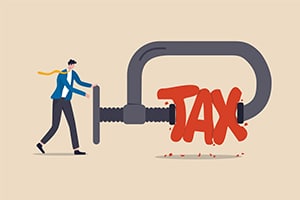
Business Advisory Services
Everything you need to help you launch your new business entity from business entity selection to multiple-entity business structures.
Hey - Our site just had a makeover and we are sorting through the hiccups!
Hey - Our site just had a makeover and we are sorting through the hiccups!

Everything you need to help you launch your new business entity from business entity selection to multiple-entity business structures.

Designed for rental property owners where WCG CPAs & Advisors supports you as your real estate CPA.

Everything you need from tax return preparation for your small business to your rental to your corporation is here.

WCG’s primary objective is to help you to feel comfortable about engaging with us
Table Of Contents

 Updated May 13, 2020 (SBA says loans under $2M are safe harbor on need for funds)
Updated May 13, 2020 (SBA says loans under $2M are safe harbor on need for funds)
Updated May 17, 2020 (Treasury releases PPP Loan Forgiveness Application recently and solved a bunch on unknowns, but also required us to change our template and this blog post a ton… frankly we and others were over-complicating it)
Updated June 3, 2020 (House and Senate pass the PPP Flex Act which changes 8 weeks to 24, 75% payroll to 60%, and 2 years for payback to 5 years… we’ll adjust our verbiage below accordingly.)
Updated June 17, 2020 (SBA released the EZ PPP Loan Forgiveness Application which streamlines the forgiveness application… detailed in our EZ PPP Loan Forgiveness Application blog post.)
As part of the CARES Act due to this COVID-19 nonsense, the SBA handed out about $600 billion in Paycheck Protection Program (PPP) loans which also contained an amazing forgiveness component. This blog post attempts to synthesize the complicated PPP loan forgiveness calculation, but we also must warn readers and small business owners of two huge things-
However, the lender is going to be fairly forgiving since they are wanting a return of their capital vis a vis the loan forgiveness calculation. Yes, the wolf is in charge of the hen house. Lenders want to unbridle forgiveness amounts so they can boost their capital reserves so they can re-lend it back out at a rate much higher than 1% (such as loans to home buyers, automobile financings, normal business debt, etc.).
The SBA recently released the loan forgiveness application for the Paycheck Protection Program. It answered a lot of questions including-
It is an 8-week period… 56 days… not two months. Update: June 3, PPP Flex Act gives borrowers the option of 8 weeks or 24 weeks.
There is an alternative payroll covered period that a business can use so their payroll cadence fits nicely. This is generally for payroll costs only leaving rent, utilities and loan interest governed by the covered period (which starts on the loan disbursement date and runs for 56 days). More on this in a bit.
Cash versus accrual. Well, according to the application it is both. The language that is used is “must be paid during the covered period or incurred during the covered period and paid on or before the next regular billing date.”
The application also created additional safe harbors for the full-time equivalent calculation and possible loan forgiveness reduction.
There are two components at play. The calculation of the PPP loan amount was based purely on payroll costs which in most cases included gross wages, employer paid health insurance, employer contribution to retirement plans or accounts, and the state and local taxes paid (primarily state unemployment… SUTA or SUI). Yes, there are some other granular details, but that covers most situations.
That is the PPP loan amount calculation. Note how rent, utilities and business loan interest are not included! Wait for it…
The second component is PPP loan forgiveness calculation, and this is based on the amounts spent during an 8-week period on payroll costs (see definition above), rent, utilities and business loan interest.
Next, the PPP forgiveness amount might be reduced depending on the amounts spent on payroll versus rent, utilities and business loan interest (the 75-25 rule that we’ll explore in a bit). Also, it might be reduced based on staffing levels before the loan and during the 8-week period, and the wage or salary amounts paid. Update: June 3, the 75-25 rule is now 60-40 and 8 weeks is optional to extend to 24 weeks.
We’ll go step by step on all this in a bit.
Please refer to our PPP loan forgiveness frequently asked questions, and revisit often since these Q&As will change as we receive more guidance. We cannot emphasize enough that a) more guidance is coming and b) lenders are the gatekeepers.
There are some controversies and other issues involving the SBA’s Paycheck Protection Program. Shocker, right?! Lawyers routinely think they are the smartest ones in the room, and lawmakers are no different. Sure, a Harvard lawyer is probably smart but not because he or she went to law school. They were already smart and got into a school full of other smart people. Anyway, we digress…
This one is freakin’ people out. By now most people have heard about the Shake Shack debacle where a publicly traded company received a $10 million PPP loan from the SBA. Read that again. A company that has access to the capital markets (ie, sell shares and raise cash) received a forgivable loan?! Hey, hate the game not the player! Shake Shack and others are returning their funds in lieu of this unintended result at the bequest of the Treasury Department. In fact, those with loans of $2 million or more will have increased scrutiny.
So, let’s break this down to Mom and Pop down the street. If you have a line of credit in place allowing you to borrow $100,000 but you opt instead to use the Paycheck Protection Program, are you in violation? We say probably not, but see for yourself. Here is the language dated May 6, 2020 from the Treasury-
Specifically, before submitting a PPP application, all borrowers should review carefully the required certification that “[c]urrent economic uncertainty makes this loan request necessary to support the ongoing operations of the Applicant.” Borrowers must make this certification in good faith, taking into account their current business activity and their ability to access other sources of liquidity sufficient to support their ongoing operations in a manner that is not significantly detrimental to the business.
However, on May 13, 2020, the Treasury came out with-
Small Business Administration (SBA), in consultation with the Department of the Treasury, has determined that the following safe harbor will apply to SBA’s review of PPP loans with respect to this issue: Any borrower that, together with its affiliates, received PPP loans with an original principal amount of less than $2 million will be deemed to have made the required certification concerning the necessity of the loan request in good faith.
So, if your loan is less than $2 million, then you only need to be governed by the “[c]urrent economic uncertainty makes this loan request necessary to support the ongoing operations of the Applicant.
Update: June 3, the PPP Flex Act changes this to 60-40, but there is a caveat. We’ll explore in a bit.
There are updated guidelines that read 60% of the PPP loan proceeds must be spent on payroll costs. This is misleading. To better grasp this, think of it in the negative. Rather, you are only allowed to spend 40% of the proceeds on rent, utilities and business loan interest (non-payroll costs). Let’s do some quick math.
 Let’s say your loan is $100,000 and you spent $50,000 on payroll costs and $50,000 on rent, utilities and loan interest in the 8-week period (or 24 weeks thanks to PPP Flex Act). This is a situation where your payroll to non-payroll is low, such as a restaurant where labor is low and rent is high. How the PPP loan forgiveness application performs this test is by taking the $50,000 spent on payroll costs and dividing it by 0.60 which is $83,333. This number represents the ultimate maximum forgiveness amount.
Let’s say your loan is $100,000 and you spent $50,000 on payroll costs and $50,000 on rent, utilities and loan interest in the 8-week period (or 24 weeks thanks to PPP Flex Act). This is a situation where your payroll to non-payroll is low, such as a restaurant where labor is low and rent is high. How the PPP loan forgiveness application performs this test is by taking the $50,000 spent on payroll costs and dividing it by 0.60 which is $83,333. This number represents the ultimate maximum forgiveness amount.
In other words, rent, utilities and loan interest would be capped at $33,333 (83,333 less 50,000), and everything beyond that would be unforgiven. Are we the only ones thinking of Clint Eastwood right now? Yeah, we know unforgiven is not a word, but we wanted to work in a Client Eastwood reference.
Where did they get the original 75-25 rule? It is simple actually. The PPP loan amount was based on 2.5 months of payroll costs which is 10.75 weeks (4.3 weeks in a month, 4.3 x 2.5 = 10.75). However, you only have 8 weeks to spend the money. Therefore, 8 weeks / 10.75 weeks is 74%, which was rounded up to be 75%. Theoretically if nothing changed over the past 12 months in your payroll world, it would be impossible to spend 10.75 weeks of payroll costs in an 8-week window (again, assuming nothing changed).
That is the logic anyway.
PPP Flex Act has language that creates a cliff. The above math is presenting a slide scale. Here is the verbiage from Page 5 of HR 7010 which the PPP Flex Act passed by the Senate on June 3, 2020-
(8) LIMITATION ON FORGIVENESS.—To receive loan forgiveness under this section, an eligible recipient shall use at least 60 percent of the covered loan amount for payroll costs
This suggests that if a business does not spend at least 60% on payroll costs, the none of the loan is forgiven. Rumor from many Senators and others is that they will make a technical correction to revert back to the sliding scale sort of math shown above but still use the 60-40 split.
The 8-week period starts the day of funding. Let’s say you are funded on April 17; your 8-week period ends 56 days later, or about June 11. What if you are a seasonal restaurant, such as a nice place on Cape Cod, where your season doesn’t start until Memorial Day weekend. You wouldn’t normally pay your staff prior to that, but now you might have to? Seems silly.
However! The other side of the argument is this; why do you think you needed the money back in April when your busy season is June, July and August? Did you truly face uncertainty? Perhaps, perhaps not. Ahhh, the chin scratcher!
That was our original post on the subject… now, June 3, the PPP Flex Act allows small business owners to extend to 24 weeks. This was in response to the above situation… or a situation where your local government restrictions prevented operations to a much later date.
There are five steps in determining your PPP loan forgiveness amount. Like many other CPA firms, we have put together a work paper to assist our clients in determining the amount and then to also present the evidence to the lender. As mentioned elsewhere, we are still waiting on further guidance, but in the meantime, here we go-
Please use our sample PPP loan forgiveness calculation form to follow along with the text below-
The first task is to determine the amounts spent on payroll costs, rent, utilities and business loan interest. There was one fundamental question that remained unanswered by the SBA and the Treasury. Do we use cash or accrual for accounting? In cash accounting, revenue and expenses are recognized on the date that they were received or paid. Cash in, cash out… simple! In accrual accounting, revenue and expenses are recognized on the date that they were earned and when the obligation was incurred.
We nerdy accountants default to accrual. It is the cornerstone of public accounting, and it also solves the timing differences between payroll periods and pay dates. The same is true for rent; for example, you pay rent on April 1 and your 8-week period starts on April 17. Doesn’t the 17th thru the 30th of April count towards your forgiveness calculation? We say Yes, and so does the Treasury and the SBA.
Update: June 3, PPP Flexibility Act of 2020 allows borrowers to also select a 24-week period.
In the PPP loan forgiveness application, they use the words, “must be paid during the covered period or incurred during the covered period and paid on or before the next regular billing date.” So, it sounds like both cash and accrual, and the option is up to the borrower.
As such, Lines 1, 2, 3, and 4 will be payroll costs, mortgage interest, rent / lease payments (don’t forget the company car!) and utilities respectively. Line 5 jumps right into the adjustments part, which is next.
If an employee’s pay is reduced by more than 25% during the 8-week period (the covered period), that amount reduces the PPP loan forgiveness calculation. How do we determine that? Good question!
According to the CARES Act, we use the previous quarter to the loan funding as our proxy. For 99% of the small business owners out there, this will be Q1 of 2020. Therefore, we take Q1’s payroll data and we annualize it for salaried employees. For example, if an employee earns $10,000 in Q1 his or her annual pay is $40,000. However, if this same employee earned $30,000 in Q1, the annual pay would be $120,000 and this employee would not be tested for pay reduction (we’ll talk about Table 2 on PPP Schedule A in a bit).
Step 1. Take the average annual salary or hourly wage during the covered period and divided it by the average annual salary or hourly wage between January 1, 2020 and March 31, 2020 (Q1). If this is equal to or is greater than 75% (0.75) then there is not a pay reduction for this employee. Yes, each employee must be tested separately.
 Step 2. Determine if a safe harbor exists. There are two components-
Step 2. Determine if a safe harbor exists. There are two components-
Step 3. The amount of pay reduction that exceeds 75% of the average annual salary or hourly wage from January 1 through March 31 is then calculated per employee and tallied (this will go on Table 1 of the PPP Schedule A Worksheet and Line 13 of PPP Schedule A). This in turn will become Line 5 on the loan forgiveness application.
The forgiveness reduction due to pay reductions is done first. In other words, the total amount spent on payroll costs, rent, utilities and loan interest is reduced by the total amount of pay reductions for each employee who annually earns $100,000 or less.
Full-time equivalents are next. Fun!
The PPP loan forgiveness application defines Average FTE as:
This calculates the average full-time equivalency (FTE) during the Covered Period or the Alternative Payroll Covered Period. For each employee, enter the average number of hours paid per week, divide by 40, and round the total to the nearest tenth. The maximum for each employee is capped at 1.0. A simplified method that assigns a 1.0 for employees who work 40 hours or more per week and 0.5 for employees who work fewer hours may be used at the election of the Borrower.
This is a little contradictory since the CARES Act Section 2301(c)(3) defines a full-time person by referencing IRC Section 4980H. IRC Section 4980H(c)(4) reads, “(A) In general The term full-time employee means, with respect to any month, an employee who is employed on average at least 30 hours of service per week.” It looks like the SBA waived their wand and deemed 40 hours was the rule.
Also, note the simplified method of 1.0 for full-time employees and 0.5 for anyone not considered full-time. This makes FTE calcs easy… however, this might not be beneficial depending on the composition of your staff. For example, if you had 15 employees working a combined 450 hours in 2019 but then had 12 employees working the same 450 hours, your FTE testing might be out of whack using the simplified method. When we prepare these numbers, we do both calculations; straight average and simplified method.
Let’s turn our attention to the safe harbors for the FTE testing and the full-time equivalent exceptions.
FTE Safe Harbor 1. If your business has not reduced the number of employees or the average paid hours of your employees between January 1, 2020 and the end of the covered period (the 8-week period following loan disbursement), then you have met this safe harbor and can skip further FTE testing. The PPP Flex Act has changed 8 weeks to be optional including 24 weeks… and it makes reference to replacing some June 30 dates with December 31. We’ll have to see how the SBA PPP loan forgiveness application gets updated with respects to the FTE Safe Harbors.
FTE Safe Harbor 2. We’ll just quote the PPP loan forgiveness application since it does a great job of explaining this one-
A safe harbor under applicable law and regulation exempts certain borrowers from the loan forgiveness reduction based on FTE employee levels. Specifically, the Borrower is exempt from the reduction in loan forgiveness based on FTE employees described above if both of the following conditions are met: (1) the Borrower reduced its FTE employee levels in the period beginning February 15, 2020, and ending April 26, 2020; and (2) the Borrower then restored its FTE employee levels by not later than June 30, 2020 to its FTE employee levels in the Borrower’s pay period that included February 15, 2020.
Update: June 3, PPP Flex Act replaced June 30 with December 31. The application verbiage above will probably be adjusted as well.
Ok, so you know how to calculate FTEs… and let’s say you don’t meet the two safe harbor tests, what’s next? The next step is to choose your FTE reference period. You have two options, and possibly three-
For seasonal employers, you can pick either of these periods or any 12-week consecutive period between May 1, 2019 and September 15, 2019.
Naturally you would want to choose the FTE reference period that had the fewest FTEs. Next, determine the FTE count during your 8-week period keeping in mind the FTE reduction exceptions which are-
FTE reduction exceptions are totaled and detailed on Table 1 of the PPP Schedule A worksheet.
Divide the FTE count during the 8-week period (again, using Table 1) by the FTE count from the reference period to determine your FTE reduction quotient (fancy way of saying ratio). This ratio cannot exceed 1 (or 100%).
Update: June 3, PPP Flex Act allows borrowers to choose either 8 weeks or 24 weeks.
Previously we took the total amount spent on payroll costs, rent, utilities and business loan interest and reduced by any pay reductions that exceeded 25%. This becomes Line 6 on the PPP loan forgiveness application. Next, take this amount and multiply it by the FTE reduction quotient; this becomes Line 8 on the application. You’re almost done!
We are adding this section to our original post since the Paycheck Protection Program Flexibility Act of 2020, or PPP Flex Act, adds additional language to the end of Section 1106 of the CARES Act under subsection (d). Let’s jump right into the verbiage-
(7) EXEMPTION BASED ON EMPLOYEE AVAILABILITY.
During the period beginning on February 15, 2020, and ending on December 31, 2020, the amount of loan forgiveness under this section shall be determined without regard to a proportional reduction in the number of full-time equivalent employees if an eligible recipient, in good faith-
(A) is able to document-
(i) an inability to rehire individuals who were employees of the eligible recipient on February 15, 2020; and
(ii) an inability to hire similarly qualified employees for unfilled positions on or before December 31, 2020; or
(B) is able to document an inability to return to the same level of business activity as such business was operating at before February 15, 2020, due to compliance with requirements established or guidance issued by the Secretary of Health and Human Services, the Director of the Centers for Disease Control and Prevention, or the Occupational Safety and Health Administration during the period beginning on March 1, 2020, and ending December 31, 2020, related to the maintenance of standards for sanitation, social distancing, or any other worker or customer safety requirement related to COVID-19.
Okay, let’s break this down a bit since there is some cool stuff here. (A)(i) and (ii) above basically says if you attempted to re-hire a laid off employee and that employee refuses to return to work and you attempted to hire others to no avail, then this does not count against your FTE calculation. We suspect there might be some unscrupulous manipulation by business owners with this provision since it is hard to verify.
(B) is stating that if you cannot justify re-hiring employees since your business activity is limited by health restrictions (think of a restaurant pulling out tables and being customer-limited and therefore server-limited) then this too does not count against your FTE count.
There are three Lines on this part. Line 8 is called the modified total, and is the amount spent on payroll costs, loan interest, rent / lease and utilities less the pay reduction amount and then multiplied by the FTE ratio (reduction quotient). Line 8! Seems like a magic 8 ball more than a line.
Line 9 is the PPP loan amount. Easy.
Line 10 is the payroll cost requirement of 60% which is computed by taking Line 1 (payroll costs) and dividing it by 0.60. So, let’s say you spent $60,000 on payroll costs, your Line 10 would be $60,000 / 0.60 or $100,000. Recall that this was 75% until the PPP Flex Act which changed it to 60% on June 3.
Simple! The smallest of Lines 8, 9 and 10. Also, thanks to the PPP Flex Act, any remainder amount is payable over 5 years instead of 2, and the interest rate remains at 1%. However, given the looser provisions of 24 weeks and 60%, most loans will be 100% forgiven. Your mileage might vary.
We’ve made reference to the PPP Schedule A and its worksheet. PPP Schedule A is required to be submitted to your lender and it is basically used to help you, the lender and the SBA tally up different numbers for payroll costs which include compensation, employer contributions for employee health insurance, employer contributions to employee retirement plans and the amounts paid for state and local taxes assessed on employee compensation (with the most notable one being state unemployment… SUTA / SUI).
PPP Schedule A also totals the pay reduction amounts and creates the famous FTE reduction quotient.
Our fees are generally based on complexity of your PPP world. If you qualify for the EZ PPP loan forgiveness but you still need us to compute payroll costs, rent, utilities and mortgage loan interest, our flat fee is $250. You will need to attest to the one of the EZ qualifiers above. If you need to use the “long” PPP loan forgiveness form or if you need us to verify that you qualify for the EZ PPP loan forgiveness application (FTE calcs, pay reduction calcs), then we have attempted to simplify the structure based on the number of employees which also includes the number of shareholders. Here are our fixed rates-
| 1-2 employees | $450 |
| 3-5 employees | $900 |
| 6-10 employees | $1,500 |
| 11-15 employees | $2,000 |
| 16-20 employees | $2,500 |
| 21+ employees | Custom Quote |
If you are one of our business advisory service clients, the PPP loan calculation and the PPP loan forgiveness calculation is considered outside of scope. However, as part of our consultation arrangement we will provide questions to your answers should you want to put together your own calculation paperwork.
For those clients who have a tax-only engagement with us, our hourly rate is $250 per hour for PPP consultation.
We have a separate engagement agreement for the PPP forgiveness component. Please visit the button below and download our PPP loan forgiveness checklist. If you have questions or concerns, please contact us at 719-387-9800 or [email protected].
Warm Regards,
Your PPP Task Force

Learn about important tax deadlines, document checklists and due dates, and other essential tax return information.
Jason Watson, CPA is a Partner and the CEO of WCG CPAs & Advisors, a boutique consultation and tax preparation CPA firm located in Colorado, and is the author of Taxpayer’s Comprehensive Guide on LLC’s and S Corps and I Just Got a Rental, What Do I Do? which are available online and from mostly average retailers.
With state apportionment and tax return preparation, there are two issues at play- apportionment itself, and then state tax return
Table Of Contents

Tax planning season is here! Let's schedule a time to review tax reduction strategies and generate a mock tax return.

Tired of maintaining your own books? Seems like a chore to offload?
Did you want to chat about this? Do you have questions about us? Let’s chat!
The tax advisors, business consultants and rental property experts at WCG CPAs & Advisors are not salespeople; we are not putting lipstick on a pig expecting you to love it. Our job remains being professionally detached, giving you information and letting you decide within our ethical guidelines and your risk profiles.
We see far too many crazy schemes and half-baked ideas from attorneys and wealth managers. In some cases, they are good ideas. In most cases, all the entities, layering and mixed ownership is only the illusion of precision. As Chris Rock says, just because you can drive your car with your feet doesn’t make it a good idea. In other words, let’s not automatically convert “you can” into “you must.”
Let’s chat so you can be smart about it.
We typically schedule a 20-minute complimentary quick chat with one of our Partners or our amazing Senior Tax Professionals to determine if we are a good fit for each other, and how an engagement with our team looks. Tax returns only? Business advisory? Tax strategy and planning? Rental property support?

Everything you need to help you launch your new business entity from business entity selection to multiple-entity business structures.

Designed for rental property owners where WCG CPAs & Advisors supports you as your real estate CPA.

Everything you need from tax return preparation for your small business to your rental to your corporation is here.

WCG’s primary objective is to help you to feel comfortable about engaging with us
